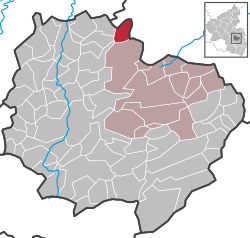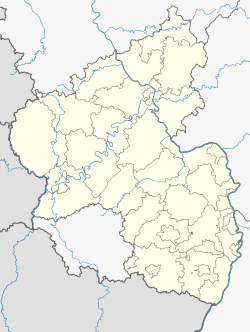Mörsfeld
Mörsfeld is a municipality in the Donnersbergkreis district, in Rhineland-Palatinate, Germany.
Mörsfeld | |
|---|---|
 Coat of arms | |
Location of Mörsfeld within Donnersbergkreis district  | |
 Mörsfeld  Mörsfeld | |
| Coordinates: 49°44′39″N 7°56′6″E | |
| Country | Germany |
| State | Rhineland-Palatinate |
| District | Donnersbergkreis |
| Municipal assoc. | Kirchheimbolanden |
| Government | |
| • Mayor | Ulrich Volker |
| Area | |
| • Total | 5.25 km2 (2.03 sq mi) |
| Elevation | 275 m (902 ft) |
| Population (2018-12-31)[1] | |
| • Total | 471 |
| • Density | 90/km2 (230/sq mi) |
| Time zone | CET/CEST (UTC+1/+2) |
| Postal codes | 67808 |
| Dialling codes | 06358 |
| Vehicle registration | KIB |
History
The area which is now Mörsfeld was originally settled at the end of the 9th century. It was supposedly named after a settler named Moro with the oldest recorded spelling of the town as "Morßfelt." About 1 km from the town itself is a place called the Daimbacherhof; a Cistercian monastery was founded there in the 13th century. In 1525, during the Peasants' War, the town as well as the monastery were destroyed. Also in the Daimbacherhof were mercury mines which were mined successfully until the early 19th century with production only being brought to a halt during the Thirty Years' War. Mörsfeld was further ravaged during a period of war from 1792 to 1801.[2] The town was occupied by the French in 1799 and remained in their control til 1814, when it was reincorporated into the Kingdom of Bavaria.[3]
List of Mayors
- 1660–1689, Johannes Wagner
- 1690–1719, Johann Jost Pfannkuchen
- 1794–1798, Heinrich Kaufhold
- 1798–1800, Johann Daniel Orschiedt
- 1811–1819, Johann Adam Lied
- 1819–1837, Karl Philipp Grieß
- 1837–1838, Johannes Nussbickel
- 1838–1848, Jacob Vogel
- 1848–1868, Johann Adam Wagner
- 1868–1889, Johannes Lawall
- 1890–1892, Adam Fellenberger
- 1892–1894, Philipp Jakob Vogel
- 1895–1915, Philipp Jakob Lawall
- 1974–1981, Julius Konrad
References
- "Bevölkerungsstand 2018 - Gemeindeebene". Statistisches Landesamt Rheinland-Pfalz (in German). 2019.
- "Archived copy". Archived from the original on 2015-12-24. Retrieved 2015-12-24.CS1 maint: archived copy as title (link)
- Schütz, Hartmut (2010). Mörsfeld - Das Familienbuch von Mörsfeld, Daimbacher Hof und Weissensteiner Mühle 1650 bis 1930. Mörsfeld, Germany. p. 6.